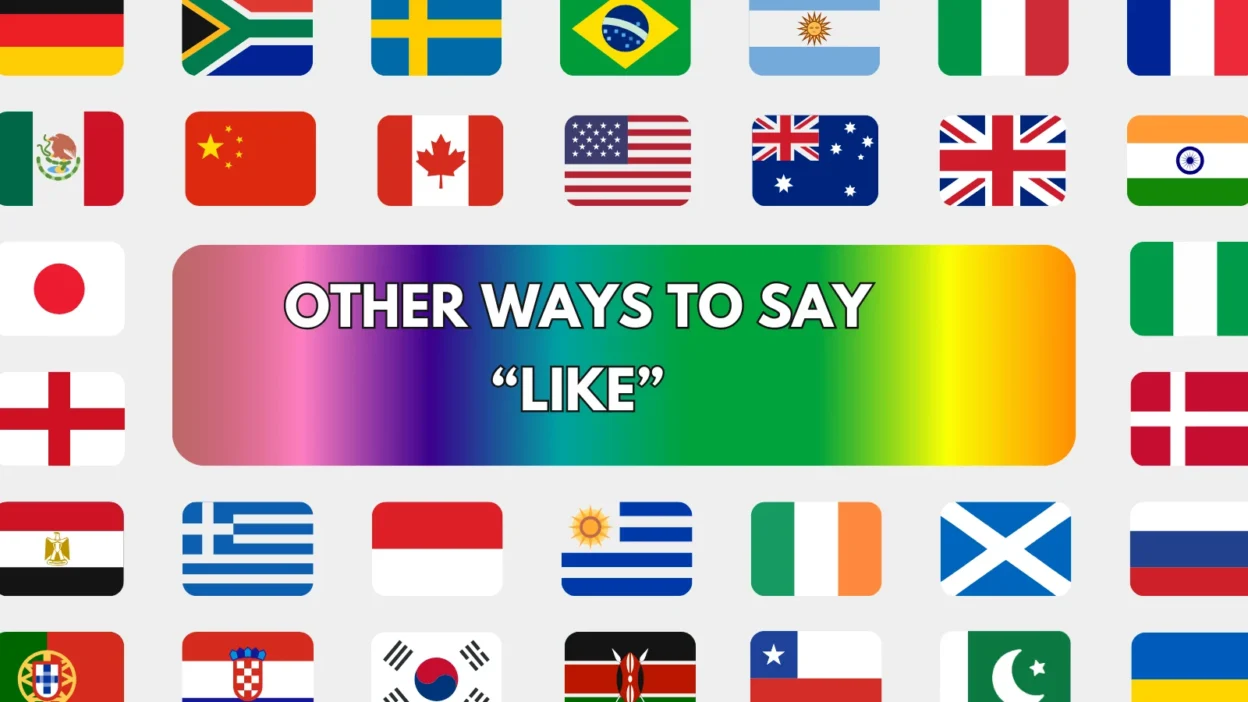The word “like” is incredibly versatile. It can be used to express preference, make comparisons, introduce examples, or simply add rhythm to speech. But because it’s used so frequently, especially in casual speech and writing, it can start to sound repetitive or vague. Choosing precise alternatives helps clarify your meaning and elevate the tone of your communication—whether you’re writing formally, explaining ideas, or telling stories.
Here are 25 effective alternatives to “like”, each with detailed guidance on usage and tone.
1. Such As
Meaning
Used to introduce specific examples of a general statement.
Detailed Explanation
“Such as” works well when listing particular items that belong to a broader category.
Scenario Example
She enjoys outdoor activities, such as hiking, kayaking, and rock climbing.
Best Use
Formal writing, essays, reports.
Tone
Professional, informative.
2. For Example
Meaning
Used to introduce a specific illustration or case.
Detailed Explanation
A clear and direct way to elaborate on a point with a supporting example.
Scenario Example
Many fruits contain antioxidants. For example, blueberries and pomegranates are excellent sources.
Best Use
Academic or instructional content.
Tone
Neutral, explanatory.
3. Similar To
Meaning
Used to show resemblance or likeness between two things.
Detailed Explanation
Good for comparisons without implying exact sameness.
Scenario Example
Her painting style is similar to that of Van Gogh.
Best Use
Descriptive writing, critiques.
Tone
Objective, analytical.
4. As If
Meaning
Used to describe a hypothetical or exaggerated scenario.
Detailed Explanation
Often expresses emotion or adds drama to descriptions.
Scenario Example
He looked as if he hadn’t slept in days.
Best Use
Narratives, expressive writing.
Tone
Vivid, emotional.
5. Resembling
Meaning
To have qualities or appearance similar to something else.
Detailed Explanation
A more formal word that focuses on physical or abstract likeness.
Scenario Example
The sculpture is remarkably detailed, resembling a real person.
Best Use
Art critique, formal comparisons.
Tone
Formal, descriptive.
6. Comparable To
Meaning
Able to be likened or compared to something else in quality or value.
Detailed Explanation
Useful for drawing structured comparisons between similar entities.
Scenario Example
Her leadership skills are comparable to those of seasoned executives.
Best Use
Professional or analytical writing.
Tone
Measured, evaluative.
7. Including
Meaning
Introduces specific examples as part of a group.
Detailed Explanation
Often used mid-sentence to mention key examples.
Scenario Example
The package includes items such as headphones, a charger, and a carrying case.
Best Use
Instructional and informative writing.
Tone
Clear, practical.
8. Reminiscent Of
Meaning
Evokes memories or resemblance to something else.
Detailed Explanation
More poetic and emotional, this phrase works well in descriptive or nostalgic writing.
Scenario Example
The scent was reminiscent of her grandmother’s kitchen.
Best Use
Literary writing, storytelling.
Tone
Nostalgic, emotional.
9. The Same As
Meaning
Identical or very similar to something else.
Detailed Explanation
Used for direct comparisons, especially when emphasizing equality.
Scenario Example
Your password should not be the same as your username.
Best Use
Technical or instructional writing.
Tone
Direct, clear.
10. In the Manner Of
Meaning
Done in a style or fashion similar to someone or something else.
Detailed Explanation
Formal expression, often used in critique or analysis.
Scenario Example
The architect designed the home in the manner of mid-century modernism.
Best Use
Art, design, professional analysis.
Tone
Formal, refined.
11. In the Style Of
Meaning
Imitating the look, feel, or form of something or someone.
Detailed Explanation
Used to explain influences in art, writing, or design.
Scenario Example
The play was performed in the style of Shakespearean tragedy.
Best Use
Creative fields, reviews.
Tone
Artistic, descriptive.
12. Think Of
Meaning
Used to prompt the listener to imagine or compare.
Detailed Explanation
Effective in speech or informal writing to build a mental image.
Scenario Example
Think of it as a digital version of your filing cabinet.
Best Use
Explanations, tutorials.
Tone
Conversational, guiding.
13. Comparable With
Meaning
Similar in quality, function, or scale.
Detailed Explanation
Often used in statistical or evaluative writing.
Scenario Example
These results are comparable with last year’s data.
Best Use
Research, data analysis.
Tone
Technical, objective.
14. Kind Of
Meaning
A vague or general resemblance or category.
Detailed Explanation
Informal, often used to show approximation or uncertainty.
Scenario Example
It’s kind of like a mix between a pizza and a sandwich.
Best Use
Casual speech, friendly conversations.
Tone
Informal, conversational.
15. As Though
Meaning
Used to describe something that appears to be the case.
Detailed Explanation
Often adds dramatic or descriptive depth.
Scenario Example
She acted as though nothing had happened.
Best Use
Creative writing, storytelling.
Tone
Emotional, expressive.
16. Alike
Meaning
Having similarities in appearance or nature.
Detailed Explanation
Often used to describe shared features or characteristics.
Scenario Example
The twins look so alike that it’s hard to tell them apart.
Best Use
Descriptive writing.
Tone
Neutral, observational.
17. Equivalent To
Meaning
Equal in value, function, or meaning.
Detailed Explanation
More technical, commonly used in formal or mathematical contexts.
Scenario Example
This amount of sugar is equivalent to three cans of soda.
Best Use
Scientific writing, academic comparisons.
Tone
Precise, formal.
18. Approaching
Meaning
Coming close to something in quality, appearance, or value.
Detailed Explanation
Used when something is nearly like something else.
Scenario Example
Her performance was approaching perfection.
Best Use
Performance reviews, artistic critiques.
Tone
Professional, evaluative.
19. Almost Like
Meaning
Something is close to being or feeling like another thing.
Detailed Explanation
Expresses similarity without full equivalence.
Scenario Example
The silence was almost like a heavy blanket over the room.
Best Use
Narratives, emotional descriptions.
Tone
Evocative, soft.
20. Analogous To
Meaning
Comparable in certain respects.
Detailed Explanation
Formal expression used in logical and academic contexts.
Scenario Example
The nervous system is analogous to a computer’s network.
Best Use
Academic, scientific, or professional writing.
Tone
Analytical, formal.
21. Akin To
Meaning
Of similar character or nature.
Detailed Explanation
Often used in thoughtful or philosophical comparisons.
Scenario Example
His passion for justice is akin to that of a reformer.
Best Use
Literary essays, reflective writing.
Tone
Intellectual, expressive.
22. As With
Meaning
Used to make comparisons or draw parallels.
Detailed Explanation
Useful when comparing processes, systems, or experiences.
Scenario Example
As with most large projects, this one required extensive planning.
Best Use
Formal writing, instructions.
Tone
Professional, structured.
23. In Comparison To
Meaning
Evaluating two or more things based on differences or similarities.
Detailed Explanation
Helps clarify meaning through contrast or parallel.
Scenario Example
In comparison to last year, sales have increased by 15%.
Best Use
Reports, analytics.
Tone
Analytical, neutral.
24. Remind One Of
Meaning
Triggers memories or associations with something else.
Detailed Explanation
Common in storytelling or emotional writing.
Scenario Example
The smell reminded her of summer at her grandmother’s house.
Best Use
Memoirs, narratives, personal writing.
Tone
Warm, nostalgic.
25. Along the Lines Of
Meaning
Something that’s in the same general direction or category.
Detailed Explanation
Useful when discussing plans or suggestions.
Scenario Example
I was thinking of something along the lines of a welcome email.
Best Use
Brainstorming, informal discussions.
Tone
Flexible, conversational.
Conclusion
Whether you’re comparing ideas, giving examples, or expressing preferences, the word “like” can often be replaced with something more precise or stylistically appropriate.
By using these 25 alternatives, you’ll improve your writing clarity, vary your tone, and better engage your audience in any context—from casual conversation to formal reports.




